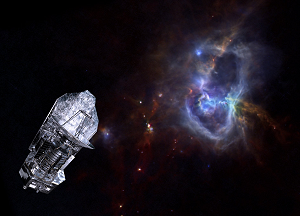 |

|
Herschel closes its eyes on the univers
The event was not unexpected: the mission began with over 2300 litres of liquid helium, which has been slowly evaporating since the final top-up the day before Herschel’s launch on 14 May 2009. The liquid helium was essential to cool the observatory’s instruments to close to absolute zero, allowing Herschel to make highly sensitive observations of the cold Universe until today. The confirmation that the helium is finally exhausted came this afternoon at the beginning of the spacecraft’s daily communication session with its ground station in Western Australia, with a clear rise in temperatures measured in all of Herschel’s instruments. “Herschel has exceeded all expectations, providing us with an incredible treasure trove of data that that will keep astronomers busy for many years to come,” says Prof. Alvaro Giménez Cañete, ESA’s Director of Science and Robotic Exploration. Herschel has made over 35 000 scientific observations, amassing more than 25 000 hours’ worth of science data from about 600 observing programmes. A further 2000 hours of calibration observations also contribute to the rich dataset, which is based at ESA’s European Space Astronomy Centre, near Madrid in Spain. The archive will become the legacy of the mission. It is expected to provide even more discoveries than have been made during the lifetime of the Herschel mission. “Herschel’s ground-breaking scientific haul is in no little part down to the excellent work done by European industry, institutions and academia in developing, building and operating the observatory and its instruments,” says Thomas Passvogel, ESA’s Herschel Programme Manager. “Herschel has offered us a new view of the hitherto hidden Universe, pointing us to a previously unseen process of star birth and galaxy formation, and allowing us to trace water through the Universe from molecular clouds to newborn stars and their planet-forming discs and belts of comets,” says Göran Pilbratt, ESA’s Herschel Project Scientist. Star birth Herschel’s stunning images of intricate networks of dust and gas filaments within our Milky Way Galaxy provide an illustrated history of star formation. These unique far-infrared observations have given astronomers a new insight into how turbulence stirs up gas in the interstellar medium, giving rise to a filamentary, web-like structure within cold molecular clouds. If conditions are right, gravity then takes over and fragments the filaments into compact cores. Deeply embedded inside these cores are protostars, the seeds of new stars that have gently heated their surrounding dust to just a few degrees above absolute zero, revealing their locations to Herschel’s heat-sensitive eyes. http://www.esa.int/Our_Activities/Space_ ... |

